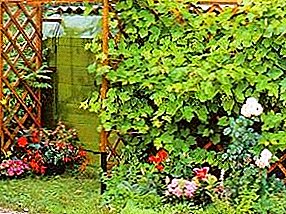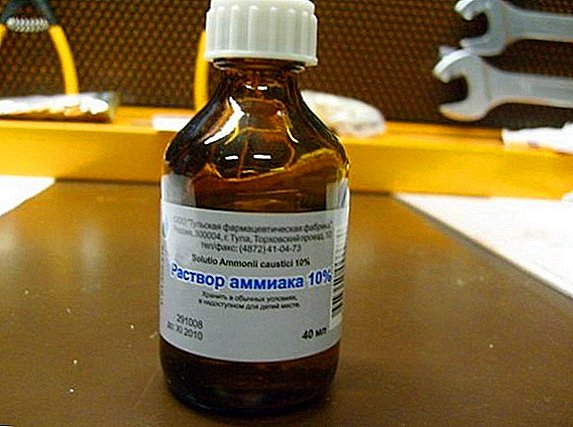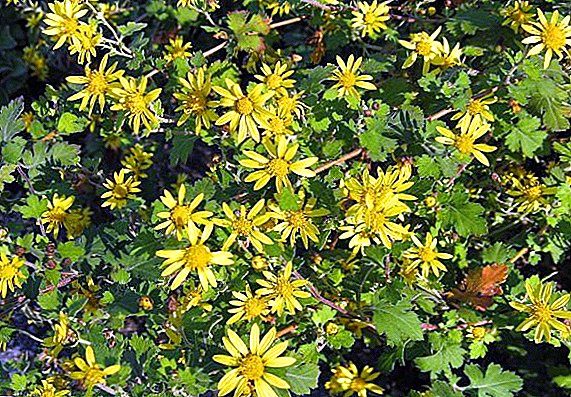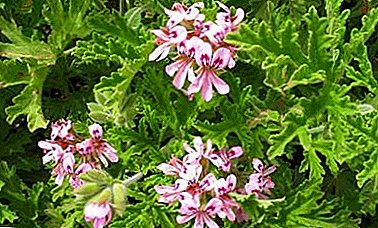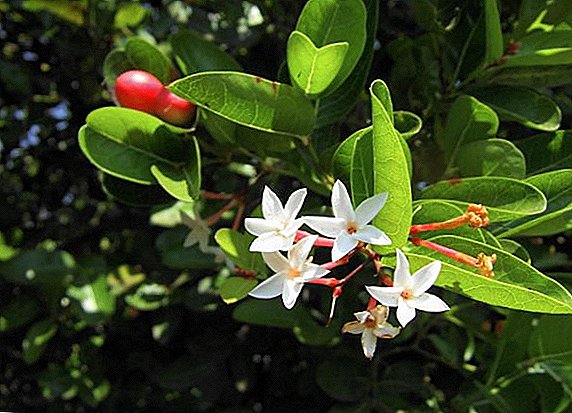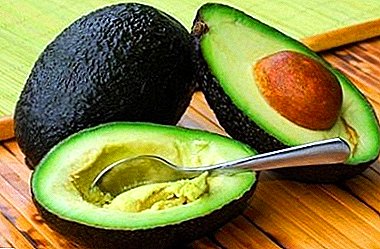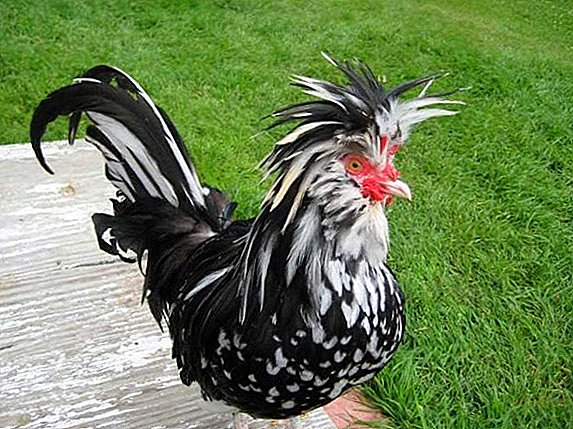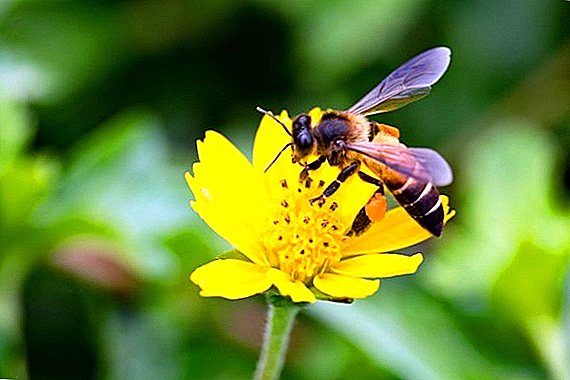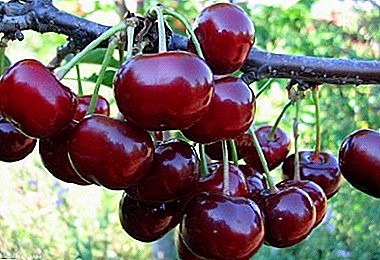
It is difficult to find a private house in Russia, near which there would not be even a small vegetable garden or a garden. And each owner of such a garden seeks to fill the area with the maximum possible variety of fruit trees.
If we recall that the cherry crop is one of the three most respected fruit crops in Russia, we can safely assume that the success of this variety with a careful approach to it is ensured.
Almost perfect combination for small Russian household plots - low growth, compactness and excellent yield - provides cherry tamaris, a full description of the variety, reviews and advice from experienced gardeners later in the article.
Breeding history and breeding region
 One of the key parameters of cherry as a garden crop has always been and remains its height.
One of the key parameters of cherry as a garden crop has always been and remains its height.
Breeders working on the creation of new undersized fruit plants come from the advantages that compact bush-like species possess.
Among their merits is minimum space occupied on the site (which allows you to place more trees on the territory), easy care and harvesting.
In addition, low cherry trees are usually better than their tall “brethren”, adapted to the conditions of close groundwater to the surface of the earth.
One of the best specialists of the famous All-Russian Research Institute of Horticulture and Nursery. I.V. Michurin (Michurinsk, Tambov region) for the removal of stunted, productive and winter-hardy varieties of stone fruit, differing besides the good taste of the fruit, is Senior Researcher the institute Tamara Morozova. It was she who became the author of Tamaris. Her hand also belong to the varieties of dessert Morozova, Lebedyanskaya.
Cherry became the "parental" variety for breeding news Consumer Black. In the process of selection, its seeds in the germinated stage of development were pretreated with the chemical substance ethyleneimine (EI). The concentration of mutagenic ethylenimine was only 0.005%.
 In 1994, a new variety was introduced into the varietal state register of the Russian Federation. Areas of preferred distribution were indicated. Central Black Earth and North Caucasus regions of Russia.
In 1994, a new variety was introduced into the varietal state register of the Russian Federation. Areas of preferred distribution were indicated. Central Black Earth and North Caucasus regions of Russia.
But at the present time, this cherry is not without success cultivated in some other Russian regions.
In these regions, they feel good and give yields such varieties as Kharitonovskaya, Chernokorka, Fairy and Black Large.
Appearance cherry Tamaris
Cherry of the specified type is characterized by the following signs:
Tree
It is a low-growing individual. 1.7-2 m high Rarely grows up to an average height of 2.5 m.
Crown, branches. A sufficiently wide, rounded crown is formed on the tree. It is characterized by medium (sometimes lower than average) thickness and distinct elevation. The bark on the trunk and main branches has a brown color. Bouquet branches are fruitful.
Shoots. Possess quite a long length. Colour - mostly brown with a brown tinge. On shoots a small amount of lentils is formed. The buds that grow on shoots are oval in shape and deviate slightly from the shoot itself.
 Leaves. Distinctive features - the average dimension, the presence on the edges of bicuspid teeth, a relatively smooth plate.
Leaves. Distinctive features - the average dimension, the presence on the edges of bicuspid teeth, a relatively smooth plate.
The glossy surface of the leaves is usually colored dark green. Downiness has not.
At the base of each leaf, 2 small dark red glands are visible. The leaf is held on a branch by means of a short, medium thick stem.
Inflorescences White flowers of the average sizes are similar to small roses. Each petal has a rounded silhouette. Standard flowering period - late.
Fruit
Pretty large and massive fruits (average berry weight ranges from 3.8 to 5 g) different round shape. The top of the fruit is slightly flattened, the base is marked by a small depression, on the abdomen there is a slight suture.
Vianok, Lighthouse and Generous can also boast large fruits.
Peel is colored dark red (purple)., on the fruits appear rare small coverslips of brown color. The same color of fleshl has a soft-soft texture with plenty of juice.
Regarding large bone round shape easily separated from the pulp. Holds the fruit on the average thickness of the stem. Between the stem and the fruit itself there is a separating layer.
A photo





Characteristic variety
Cherry Tamaris belongs to the category self-fertile fruit crops. Due to the practically equal height of the pistil (the berry develops from it) and the stamens, in the anther of which the fertilizing pollen is contained, the ovary of the future fetus takes place inside the still closed (in the bud) flower.
This factor contributes to the formation of productive ovaries and the maintenance of normal conditions for their development.
Tamaris’s self-fertility factor means that this cherry variety able to tie fruit without participation in the pollination process of third-party pollinators, only due to self-fertilization.
Experienced gardeners claim that the average yield of this variety increases markedly in cases if additional pollinators are planted next to it - Turgenevka, Zhukovskaya, Lyubskaya cherry trees.
Along the way, it is worth noting that the described variety, for its part, is a quality pollinator for some other types of cherry.
Volochaivka, Novella and Yenikeev Memories belong to the self-propelled varieties.
 According to observations, the yield of one average tree that begins to bear fruit for 2-4 years of your lifeis approximately 8-10 kg.
According to observations, the yield of one average tree that begins to bear fruit for 2-4 years of your lifeis approximately 8-10 kg.
In the conditions of the city of Michurinsk - the homeland of the variety Tamaris - the harvest of this cherry from one hectare is 65-80 centners.
Good yields are also demonstrated by the varieties Nadezhda, Shubinka, Uralskaya Rubinovaya and Rossoshanskaya black.
Good productivity is promoted, in particular, by one more essential property of this cherry - quite late terms of its maturation.
This helps the plant to avoid the detrimental effect on the emerging fruits from the frosts, quite real and frequent in early spring. Berries are traditionally filled with ripeness the second decade of July - in early August.
By the time the ripe fruit is picked, it becomes characteristic of this variety. sweet and sour taste. Moreover, the sweetness in it is still somewhat higher than the acidity (it is believed that the acidity is on average).
The biochemical composition of ripe tamaris is as follows:
| Composition | amount |
|---|---|
| Sugar | 9,98% |
| Acids | 1,68% |
| Vitamin C | 38 mg / 100 g |
It should also be noted high degree of winter hardiness of its wood.
 In addition, a small growth of trees of this variety is a good option for areas located in the region with frequent strong winds: short branches under the gusts of wind break relatively rarely.
In addition, a small growth of trees of this variety is a good option for areas located in the region with frequent strong winds: short branches under the gusts of wind break relatively rarely.
On the whole, the Tamaris cherry is a very well adapted variety to the climatic and soil features of central Russia.
Among winter-hardy varieties, one should pay attention to Vyanok, Zhukovskaya and Morozovka.
Planting and care
In order for the tree of this variety to develop normally in the future, it is well and regularly bearing fruit and does not hurt, at a young age it should be planted on a suitable site that meets the requirements of agricultural engineering.
These requirements include: a large amount of sunshine, good airing of the area, a sufficiently deep occurrence of groundwater, as well as the presence of light, loose and loamy soil.
Planting cherry is made either in the springeither in the autumn. In the first case, this should occur before the disclosure of the kidneys, in the second - no later than October.
According to experts, spring planting is preferable because of the risk of freezing of the seedling in the fall, with the onset of early frosts.
Since the Tamaris variety refers to bushy crops, it should be planted in such a way that would be to the nearest fruit plants not less than 2 meters.
 Planting seedlings carried in the landing hole, the depth and diameter of which should be 50 cm.
Planting seedlings carried in the landing hole, the depth and diameter of which should be 50 cm.
In any case, the entire root system of the plant should be completely and freely fit in a properly dug hole.
After the hole has been dug, a mixture of humus, superphosphate (40 g), potassium chloride (20-25 g) and wood ash (about 1 kg).
In the case of high content of clay in the soil, one bucket of ordinary river sand is poured into the hole.
Before planting, it is also necessary to prepare the sapling itself, especially for the roots. If they have clearly damaged processes, they must be cut. Dried roots should Be sure to soak in water, spending at least 2-3 hours.
Immediately before landing in the center of the fossa drive in a wooden peg, to which, later, for greater stability, a young, not strong tree will be tied.
The seedling should be installed in the hole, carefully straightening the root system. The barrel must be in strictly upright, on the north side of the central peg.
The pit with the seedling established in it, the ground that was previously dug out and mixed up, is filled up with a small amount of fertilizer.
The soil at the base of the trunk neatly tamped, and in a radius of 50 cm from the trunk make an earthen roller. The funnel thus formed Pour 2-3 buckets of cold and pre-settled water.
 So that later there is no rapid evaporation of moisture and no cracking of the soil, the foot of the seedling is covered 2 cm thick layer of compost or sawdust mulch.
So that later there is no rapid evaporation of moisture and no cracking of the soil, the foot of the seedling is covered 2 cm thick layer of compost or sawdust mulch.
Care for the Tamaris variety is in the traditional set of activities for cherry varieties - in regular watering periodic loosening the soil, fertilizing and pruning.
Potash phosphate fertilizers usually add during the autumn digging.
In the spring under the cherry bush contribute nitrogen fertilizers.
Organic fertilizer (compost, manure) introduced at least once in 3 years.
Top dressing in the form of mullein and ash perform twice a season - during and 2 weeks after flowering plants.
We should not forget about regular pruning (shortening) of branches. In the case of the prolific Tamaris, it is necessary, since the branches under the load of a good harvest can break off.
If you need a completely unpretentious variety for your garden, pay attention to Volochaevka, Moscow Griot and Toys.
Watch the video with a full description of the rules of planting cherries.
Diseases and pests
To avoid possible damage to the bark by rodents in the winter, wood should be protected in advance. Anyone can do this. dense material, which is wrapped around a tree table on the eve of winter.
 It should also be noted very high resistance of this variety to the common fungal disease coccomycosis. Such varieties as the Princess, Minx, Ashinskaya, Fairy are well opposed to this scourge.
It should also be noted very high resistance of this variety to the common fungal disease coccomycosis. Such varieties as the Princess, Minx, Ashinskaya, Fairy are well opposed to this scourge.
Tamaris is a small cherry tree with great potential.
True, without the labor of a person - stubborn, but joyful - it is almost impossible to reveal him.
A worthy payment for all efforts will be the pleasure that its fruits give.


